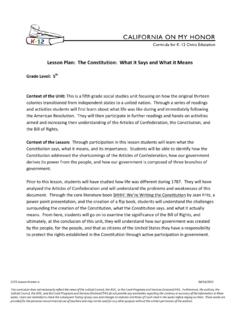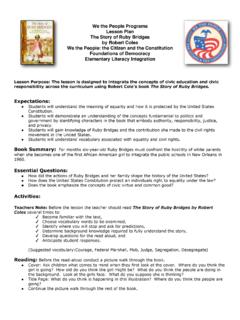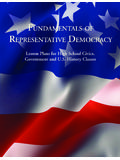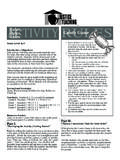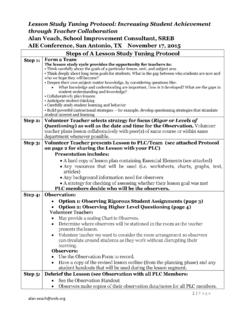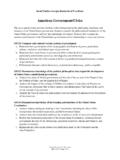Transcription of Constitutional Convention: A Decision-Making Activity
1 Constitutional convention : A Decision-Making Activity (Designed for 8th Grade Social Studies Students). Written By William Pavao Central Middle School Quincy, Massachusetts 02169. September 2009. Table of Contents Abstract ..3. lesson Goals/Objectives ..3. Key/Essential Questions ..3. Note to Massachusetts Curriculum Standard ..3. Background Narrative ..5. Teacher's Information Sheet ..9. lesson : Constitutional convention : A Decision-Making Activity ..10. Annotated Bibliography ..16. 2. Abstract This lesson was designed to help students gain a deeper understanding of the Constitutional convention of 1787 and some of the issues faced by the delegates.
2 This lesson should be taught within a unit on the United States Constitution. The simulation as outlined in this lesson is designed to meet the needs of 8th grade students and is meant to fit into two class periods. lesson Goals/Objectives 1. Students will be able to explain some of the issues faced by delegates at the Constitutional convention . 2. Students will be able to describe how different states addressed these issues. 3. Students will be able to describe how the outcomes of the simulated Constitutional convention compares to the outcomes of the actual event.
3 4. Students will analyze United States Census data from which to gain information. Key/Essential Questions 1. What were some of the issues faced by the delegates at the Constitutional convention ? 2. How did states differ over these issues? 3. How did the outcomes of the simulation of the Constitutional convention compare to the outcomes of the actual event that took place in Philadelphia in 1787? Note to Teacher This simulation is designed to strengthen student understanding of the issues faced by delegates at the Constitutional convention . This lesson is not designed to introduce these topics, but rather to reinforce them once they have been taught.
4 Therefore, in order for students to more fully comprehend this simulation lesson , they already should have a basic understanding of: A. the Constitutional convention and the roles of the delegates B. the issues that the delegates at the Constitutional convention had to contend with (such as representation in Congress and slavery). C. Virginia Plan/Large State Plan D. New Jersey Plan/Small State Plan E. Connecticut Compromise/Great Compromise F. Slavery Compromises 3. Massachusetts Curriculum Standard Explain the roles of various founders at the Constitutional convention .
5 Describe the major debates that occurred at the convention and the "Great Compromise" that was reached. (H,C). Major Debates A. the distribution of political power B. the rights of individuals C. the rights of states D. slavery Founders A. Benjamin Franklin B. Alexander Hamilton C. James Madison D. George Washington 4. Background Narrative By 1787, the United States was in crisis. The then-current form of government under the Articles of Confederation was mostly ineffective. Interstate commerce was a major problem as states placed tariffs on goods from other states.
6 There was no national executive, no real judicial branch (Congress acted as the judicial branch). The legislative branch consisted of a unicameral or one house congress. Congress was limited in its powers so as not to interfere with the powers belonging to the individual states. In the spring of 1787, Alexander Hamilton, a prominent New York attorney, organized a convention to take place in Philadelphia's Independence Hall. The purpose of the convention was to discuss and remedy the problems associated with the Articles of Confederation. Each state was invited to send delegates to participate in the event.
7 The Philadelphia convention (later to be known as the Constitutional convention ) began on May 25, 1787. Twelve of the thirteen states sent delegates. The only state to boycott the proceedings was Rhode Island. In total, 55 delegates would play a role at various times in the convention . The delegates who participated in the convention did not reflect the diversity then present in the nation. Many of the delegates were wealthy planters or lawyers. Many owned slaves. Since they were not considered viable participants in the political process, women, blacks, and Native Americans were not represented at the convention .
8 The leader of the convention was Revolutionary War hero, George Washington of Virginia. Washington assumed command of the debates, yet did not take part in the debates themselves. Benjamin Franklin, representing his adopted state of Pennsylvania, was the oldest delegate present at 81 years of age. James Madison, arguably the most prepared delegate, took 5. copious notes during the confidential debates that followed. His role at the convention would eventually earn him the title, "Father of the Constitution". As the delegates discussed ways to repair the Articles of Confederation, it soon became apparent that they were designing a new system of government, one more suitable for the young United States.
9 However, issues soon arose that created contentious debate amongst the delegates. One of these issues dealt with the very nature of the new government. The states with larger populations favored James Madison's Virginia Plan. This plan consisted of a strong national government with three branches (Executive, Legislative, and Judicial) and a bicameral (two house) legislature (Congress) with a Senate and a House of Representatives whose memberships would be based upon a state's population. Madison's plan also gave the national government the power to tax, a power that rested solely within the states under the Articles of Confederation.
10 The less populated states, feeling threatened by Madison's plan, created another plan of government. The New Jersey Plan, written by William Patterson of New Jersey was also known as the Small State Plan. This plan mirrored one part of the Virginia Plan in that it called for a national government of three branches (Executive, Legislative, and Judicial). However, the Legislative Branch would be unicameral (one house) with each state having only one vote. The states would maintain the sole power of taxation. In essence, the New Jersey (or Small State Plan) was very similar to the government under the Articles of Confederation.
